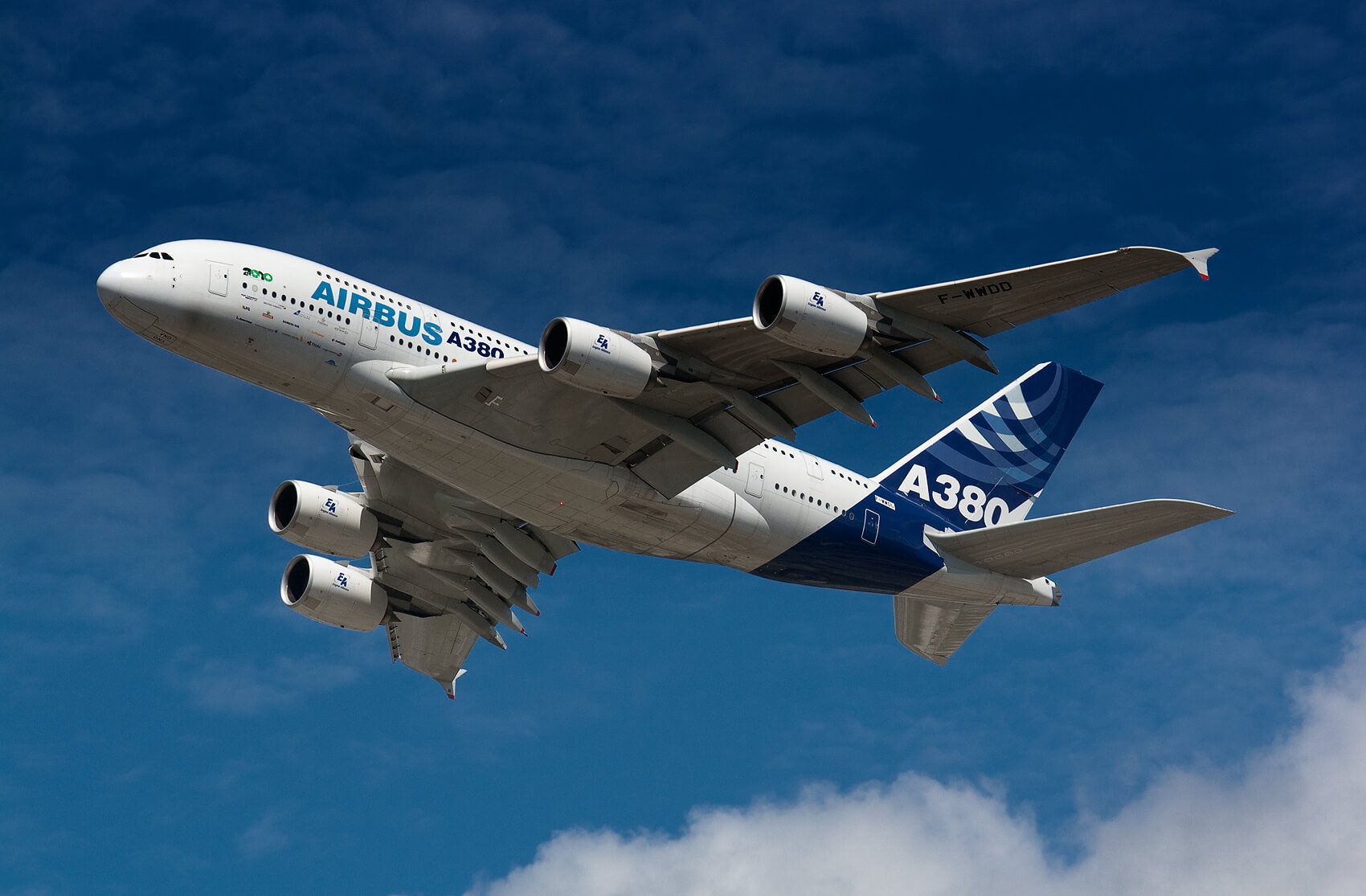
Redeeming airlines miles for an award ticket is a difficult yet very rewarding task. You will find that although different airlines usually have different rules, they still share many similarities. In this post, we will introduce some basic knowledge on how to redeem miles for flights. As this is not the simplest of tasks, it will be extremely helpful to use this article as a reference while you also search on the airline websites.
For the perspective of my own experience, there are several core issues of the bonus tickets redemption with miles/points:
Contents
1. The most basic concept: Saver Award Ticket
Lots of you may ask: Why does everyone say that the ticket redemption with UA miles from US to China is only 35k? When I searched, it was 80k! Or something along these lines.
There are many Airlines whose award tickets have several redemption levels. The lowest level, what is usually published on award charts, is the Saver level ticket. Above that, there are Standard level tickets (sometimes referred to as Anytime, etc).
Generally speaking, when we discuss award tickets, we only consider the Saver level ticket, there are two reasons:
- The Saver level ticket requires the least mileage. Typically the required mileage for a standard level ticket is much, much higher and not worth the redemption. That being said, Saver Award space is often limited. There are some cases, United being one of them, in which some membership programs will allow those with status to see extra Saver Award space.

EWR-SFO from UA, we can see that a non-saver award requires double the miles of a saver ticket…

Business/First Class Non-Saver is extremely expensive and is therefore not considered.
- Partner airlines are only able to see tickets when the airline releases saver space. If you can’t see it on a partner site, you will not be able to use those partner miles to purchase the flight. In some cases it’s difficult to find the bonus tickets even when there is saver space. We’ll go over some basic situations you may run in to when trying to book a partner award:
- The airline you want to fly needs to release Saver Award space, then you can redeem it with the miles of other airlines. If there is no Saver Award space, you can’t redeem with the miles of partner airlines.
- Sometimes airlines will place restrictions on search results. For example, SQ blocked its two class tickets search from other airlines. Also, DL initially blocked the KE and CZ award tickets search on certain dates with its own engine
- Besides the above restriction, another common issue is that online search can’t find a flight, but customer service is able to see and redeem the flights for you. A typical example is using AA miles to redeem for CX flights. The AA search engine is unable to see any CX tickets, but you can call AA custom service and they will be able to see saver space and redeem for you in its internal system.
- The most frustrating case is that of the Phantom ticket. This is when an airline releases saver space but no partner airlines are able to see it, unfortunately we have no resolution of this condition.
2. The required miles: Award Chart
The award chart basically defines a frequent flyer program and the value of your currency. The required points/miles for a saver level award are determined by this chart. Generally speaking, there are three kinds of award charts; Distance based, Zone based, and Ticket Price based.
Here are some examples:
- Distance based Airlines: British Airways, Asia Miles, Qantas
- Zone based Airlines: United Airlines, American Airlines, ANA
- Price based Airlines: Virgin America, Southwest
Besides the three basic types, there are also three extra points:
- Many Airlines have separate pricing for redeeming their own flights and for redeeming partner flights. The well-known airlines like: UA, ANA, British Airways, AA etc.all adopt this practice.

Award Chart of ANA’ s redemption on Star Alliance partners, you can compare it with the below chart
- Some award charts are variable based on time of year, such as BA, ANA, KE, AA . Low season redemptions typically require much less miles-different airlines have their own definition of low/high seasons.

ANA’ s award chart for it’s own flights, there are three price points: Low, Regular, and High season
- Some airline’s round-trip redemption require less miles compared to the redemption of two one-way tickets, the typical example is Asia Miles. Further, some airlines, like ANA, don’t allow one-way award tickets.

The redemption of Asia Miles round-trip tickets are much cheaper than the two single-trip
Now we will discuss the award chart types in more detail.
2.1. Distance Based
Just as its name implies, the required redemption miles are correlated with the flight distance. Below is an example of the old BA partner chart, this was changed February 2016 with the only change being that <1150 miles is now 7500 miles. This is a very useful tool for finding out the distance/prices between airports!

Award Chart for booking partner flights with BA Avios
Within this category of zone based award charts, there are differences among different airlines in terms of pricing for connecting flights
- British Airways: the total miles needed for a flight is the sum of the miles needed for each leg of that flight. For example: If the first leg is 300 miles and the second is 1500 miles, then the totally required miles is 7500+1000=17500. This is why using Avios is typically not recommended for flights with connections.
- Asia Miles: determined by the total flight miles. Take the above example, for Asia Miles, the pricing is based on 1800 miles instead of pricing two flights out.
As for how to calculate the flight distance, you can use Great Circle Mapper.
2.2. Zone Based
This is the most common type of award chart. The number of points is based on your departure region and your arrival region.
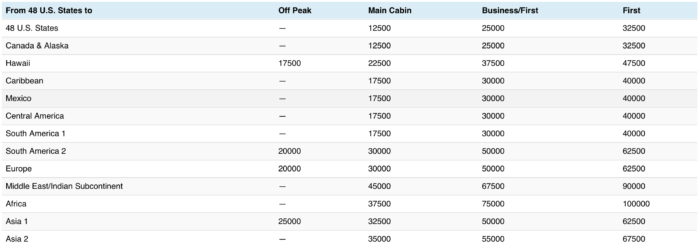
Award Chart for redeeming AA miles on partner flight when departing from the continental US.
In the chart above; Los Angeles-Hong Kong, New York-Hong Kong, Los-Angeles-Beijing, and New York-Beijing, all require the same number of miles. Economy/Business/First of a one-way are 35k/55k/67.5k respectively. This is because New York and Los Angeles belong to the 48 US states, and Hong Kong and Beijing belong to Asia 2. Of course it can’t all be so simple and there are also a few other conditions that need to be met. We will introduce some of these below.
Generally, Airlines will divide the world in the following regions: North America, Central America, Northern South America, Southern South America, North Africa, South Africa, North Asia, South Asia, South Pacific(Oceania), Europe, Central Asia, Indian Subcontinental. Subtle differences definitely exist and can often make a currency much more or much less valuable.
- AA classifies Japan, South Korean, Mongolia as Asia 1, China and South Asian countries as Asia 2. Other airlines may be more willing to classify China, Japan and South Korean as one region.
- Normally, Israel should be classified as Middle East, but Flying Blue treats it as Europe 3
- One problem with North America: do Hawaii and Alaska belong to it? Some airlines classify it together with US Continent and Canada, others do not. The same problem also applies to countries such as Mexico and the regional division of Caribbean and its nearby Islands.Typically these flights are more expensive so it’s advantageous when award charts group them with North America.
- For some airlines, though they are zone based, they treat some higher demand routes specially. For example, Eva Air needs 5k more miles when redeeming from Houston, New York, and Toronto. On the contrary, Virgin Atlantic needs less miles for popular Delta routes, for example, you need only 40k miles for a JFK-LHR RT ticket, while other routes usually need 60k.
These subtle differences in zones are great ways to find sweet spots!
In summary, for this kind of redemption: you can directly go to the airlines website and can price out your award ticket simply by having your departing zone, arriving zone, class, and maybe time of year.
2.3. Price Based
This one is the most simple to understand, the cost in points is directly correlated with ticket price. The advantage is that the value of your points is normally fixed, the demerits are that when the price is expensive, you need more points, especially for higher class tickets.


You can see that VS points are valued at about 2.1-2.4 cents per point
Another great thing about price based awards is that if you see a ticket, you can book it with points!
3. Choose the Airlines: Routing Rules
This most interesting routing rules for award tickets are stopovers and openjaws. We will also mention some other routing rules.
3.1. Stopover
Simple put, a stopover means you can stopover in a certain place of your itinerary for a period of time, and then continue your itinerary. Generally, people like to travel to one more place with one trip ticket by this rule, see the picture below;
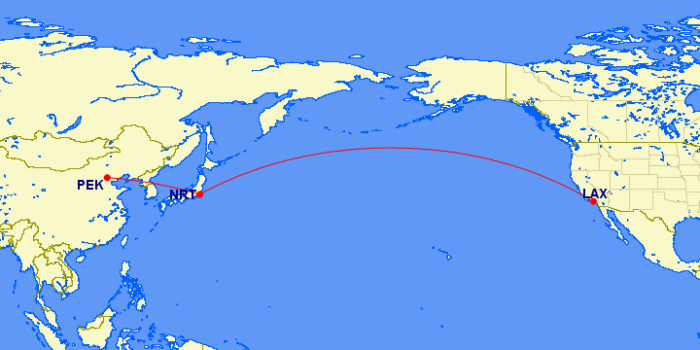
Beijing-Los Angeles, with a stopover in Tokyo
If it is allowed by the policy of airlines, then you can spend several days traveling in Tokyo with only one redemption. A definition of stopovers, for the US airlines, is:
- International Travel Itinerary: a stopover is a connection that exceeds 24 hrs
- Domestic Travel Itinerary: a stopover is a connection that exceeds 4 hrs
So we can see that, if a stopover policy exists, we can save mileage by combining two trips in to one!
3.2. Open jaw
This is for round-trip tickets, generally there are two kinds: departing zone open jaw and arriving zone open jaw:
- Departing zone open jaw: departing from A to C, but returning from C to another place B

Beijing to Los Angeles, and returning from Los Angeles to Shanghai again. Then Beijing, Shanghai is an open jaw
- Arriving zone open jaw: departing from A to C, but returning from another place B to A
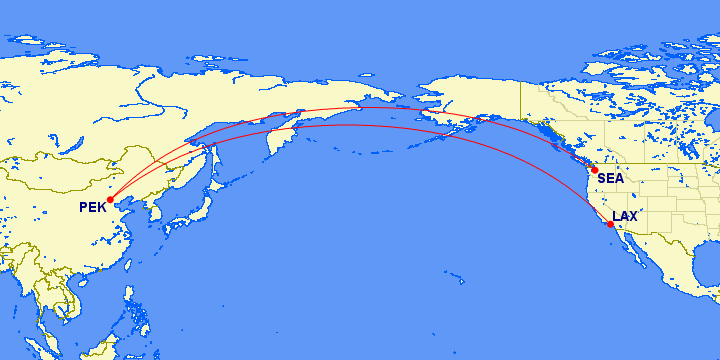
Form Beijing to Seattle, but returning is from Los Angeles to Beijing. Seattle, Los Angeles is an open jaw
Utilization of open jaws will make your itinerary much more flexible as the departing and arriving zone don’t need to between the same cities. Some may ask, can we use both the departing and arriving zone open jaws? Yes, if the airlines allow two open jaw in your round-trip.
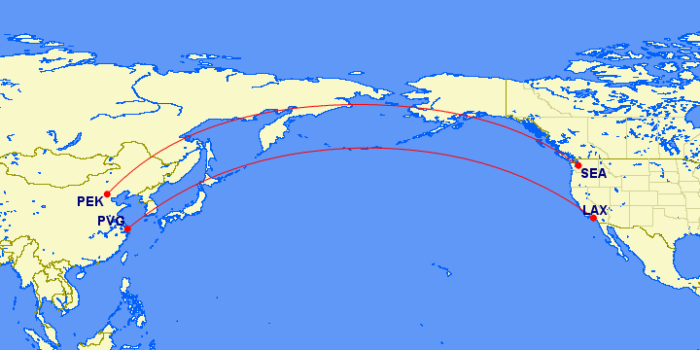
Both departing and arriving zone have the open jaw, which looks like two one-way tickets.
Further, some airlines allow two open jaws of round-trip tickets and a stopover. Then we can arrange a trip around the world on one award ticket.
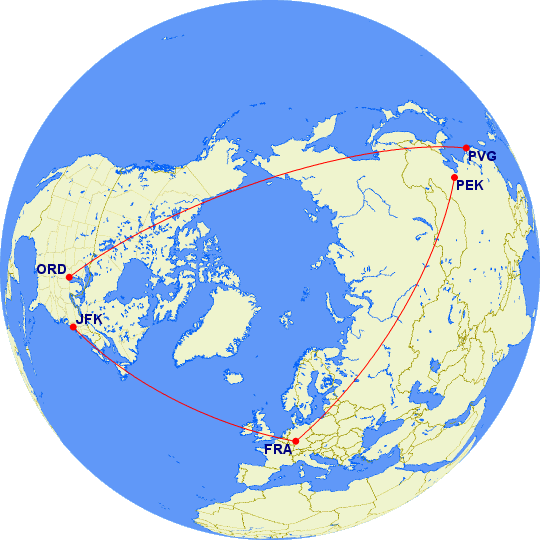
Stricly speaking, this is not a round world trip, just a trip around the North Hemisphere
By utilizing open jaws and stopovers, you can enjoy a lot of places in one trip without using more miles. One may ask, the two open jaw examples above just seem like two one-way tickets. This is true, but two one-way tickets does not always add up to one round-trip as we mentioned earlier.
- Some airlines allow you to redeem one-way tickets, such as UA. But some airlines, such as ANA, will only let you redeem round-trips. Generally speaking, if you are allowed to redeem one-ways, you should have no problem with redeeming open jaws.
- Just because an airline offers stopovers and also one-way tickets, does not mean you will be able to build in a stopover on a one-way. This is the case for UA where a roundtrip can have a stopover, but not a one-way.
We don’t want to summarize the stopover and open jaw policies of each airline in this post, we will introduce it in another post later.
We suggest that you do a quick search online as many US authors have a much more detailed summary already.
Besides the problem of whether adding a stopover or open jaw is even permitted, another concern is when/where we can utilize these tricks.
3.3. Limit rules of other airlines
Besides the stopover and open jaw policy mentioned above, there are also some others that you are maybe not that familiar with.
- Trans-regional issue: certain routes are not allowed due to crossing regions that don’t make sense. For example, when departing from China to US, you cannot pass through Europe, you have to fly across the Pacific. Also, you typically can not stopover in the same region you are departing from. With open-jaws, you typically have to open jaw within the same region, or else the system will not treat it as a full round-trip and your flight will be priced out as two one-ways.
- Limitation on flight miles and legs: even though we may meet the above requirements, airlines may still have limitations based on distance and the number of legs.
4. Fuel Surcharges (YQ)
We saved the best for last. You’ve gone through hours of searching to find your perfect flight and you see that the airline wants your hard-earned miles and also your hard earned cash! These surcharges can greatly reduce the value of your miles and sometimes render them completely useless. A typical example is the redeeming a British Airways award flight, you can see the pictures below:

18th February 2016, New York JFK- London LHR, requires 20k+$256

The same flight when paying with cash
This is a clear case where miles are rendered useless as your 20k Avios are worth $312 – $256 = $56.
A brief summary on YQ:
- Star Alliance
- United Airlines: UA redemption have no YQ
- ANA: many airlines of ANA have YQ, but good news is that the redemption of the direct flight from Mainland China to US has none
- Singapore Airlines: SQ redemption of itself have the YQ, but it’s ont very high. SQ redemption for UA and AC have none
- OneWorld
- British Airlines: many flights of BA redemption have YQ, but redeeming for AA have none if only avoid the trans-Atlantic flights
- America Airlines: AA is also very good in this point, no YQ unless redeeming for a BA flight
- Sky Team
- Delta: redeeming for DL and KE have none, international flights of China Eastern Airlines(CEA) and China Southern Airlines (CSA) have YQ, domestic do not.
- Flying Blue: Flying Blue redemption of DL don’t have YQ, redemption of CEA and CSA same as above
- Korean Airlines: KE has YQ for the redemption of its own flights
- Non-Alliance Airlines
- Virgin Atlantic Airways: none when redeeming for DL and VX
- Virgin US: YQ when redeeming with partners such as SQ
5. Airlines Ticket Availability
It’s important to remember that all of this knowledge is rendered useless if the airline does not have award tickets available. For example, you need to book almost a year out (when airlines first release seats) to get two first class tickets of Qantas. As a matter of fact, you need to book this far out when looking for multiple tickets of higher class to any international destination.
- Quantity of the award ticket: some airlines sell more, such as UA.
- Block issue: we have mentioned above, airlines each other have the right to block the search of miles tickets or redemption initially. For SQ, even though you SQ will show First class availability, you will not be able to purchase it with UA miles.
5.1. Quantity of award tickets
Generally, airlines will open up award space on a certain date long before the flight. During this time, they may add space or remove space. Previously, Delta would not open up more award space and would rather have an empty seat than sell an award seat.
Cathay Pacific is moderately generous, and they will open up award space about one year before departing but also sell the unsold seats as award tickets about two weeks before departing!
Generally, the quantity of award tickets is closely related with the size/presence of the airlines.
5.2. Block search/redemption
In summary:
- Singapore Airlines: SQ basically blocks the redemption of its higher classes by its partner airlines, so the best way to redeem the SQ higher class flights is with SQ miles
- Air China: it seems that CA has had some issues with UA, previously we can search the tickets of CA successfully on the website of UA. Some folks are able to redeem these tickets by calling UA customer service. If you want to search for CA awards tickets before you call, you can search through ANA and AC
- Cathay Pacific: AA can’t search Cathy Pacific directly, but you can search via BA and JL and then make calls to AA customer service to purchase
- China Southern Airlines: DL will block the redemption of CZ with DL miles during certain dates and generally they will list out the time of the year when the redemption is impossible.
- Korean Airlines: same as above.
